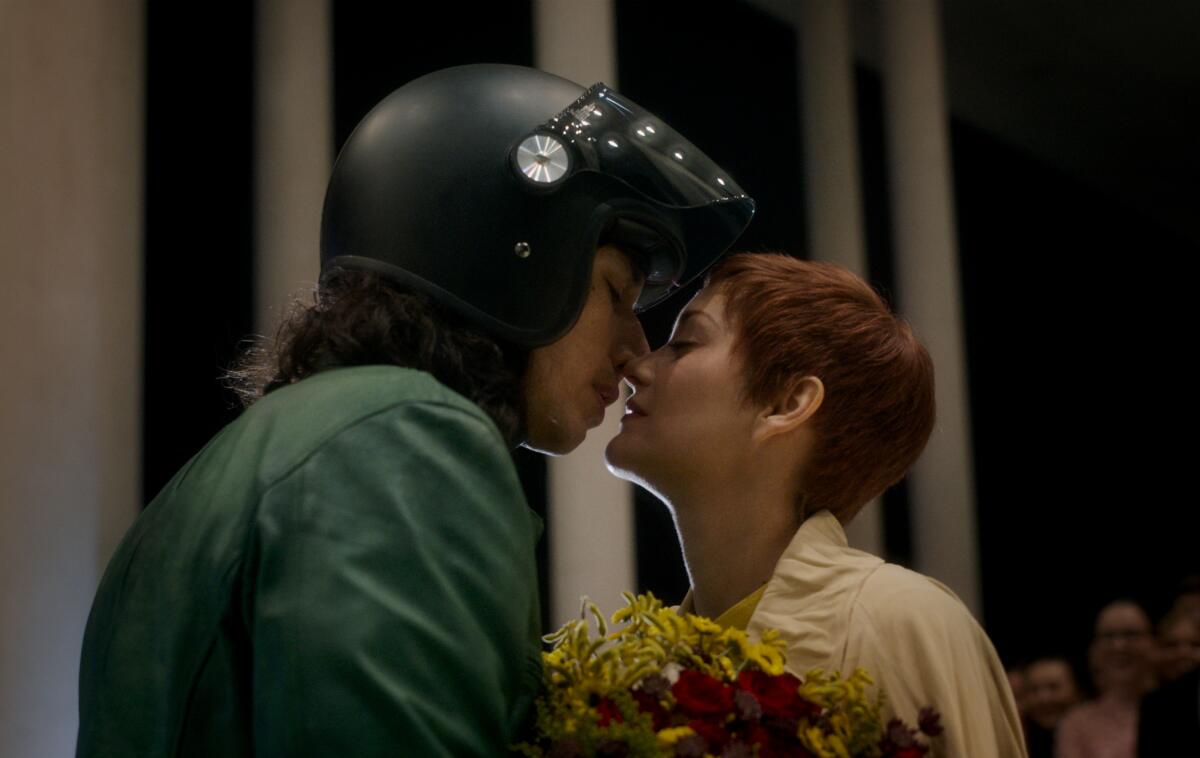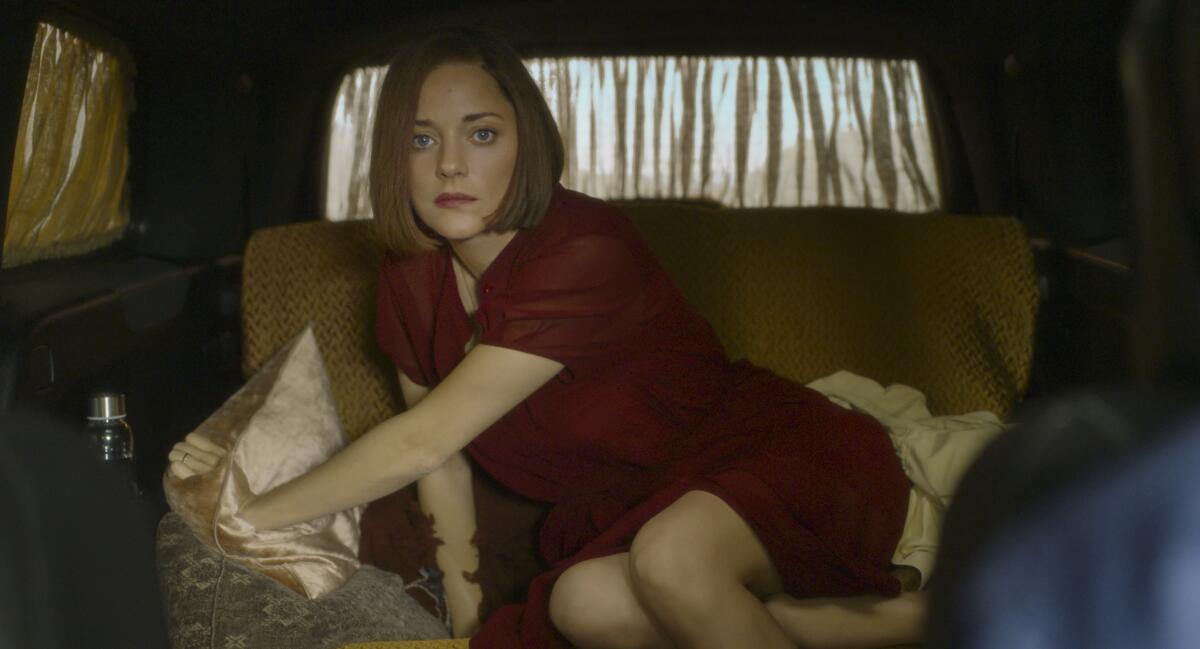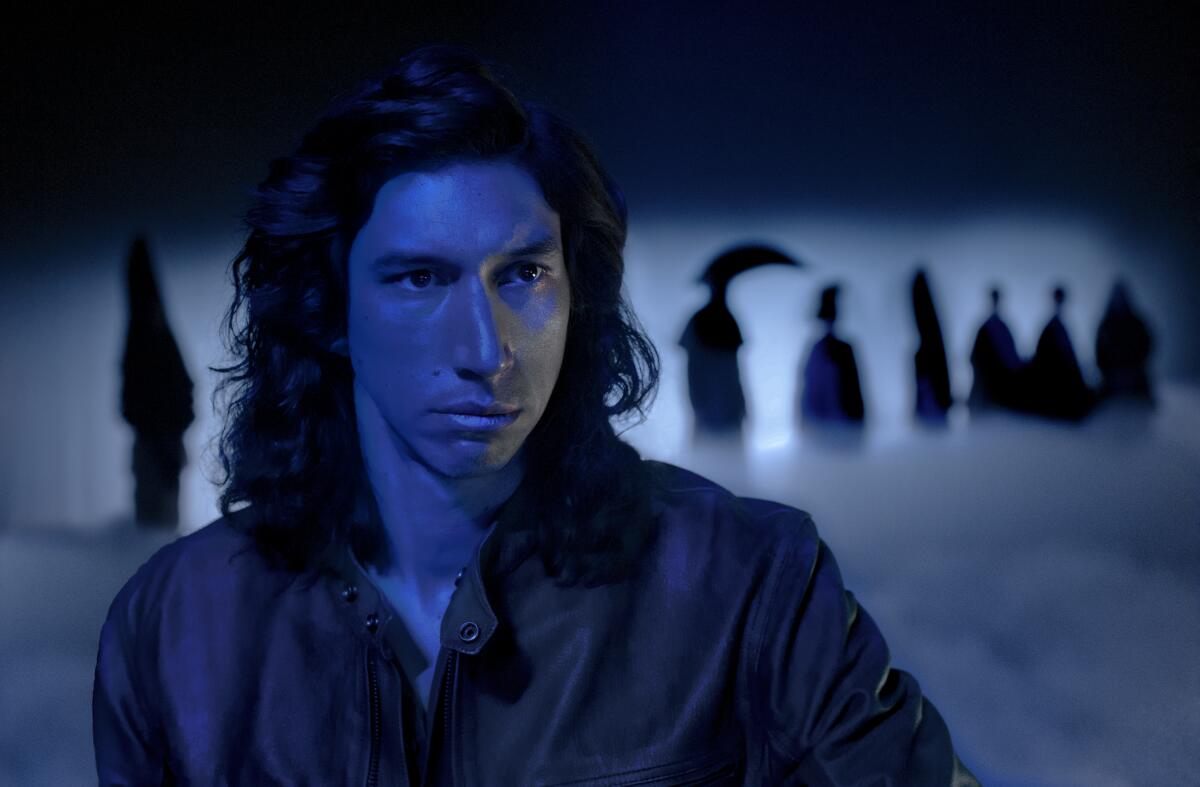Review: Adam Driver sings, rages and burns up the big screen in the entrancingly weird âAnnetteâ

The Times is committed to reviewing theatrical film releases during the COVID-19 pandemic. Because moviegoing carries risks during this time, we remind readers to follow health and safety guidelines as outlined by the Centers for Disease Control and Prevention and local health officials.
Ann Defrasnoux is an opera singer. Henry McHenry is a stand-up comic. Their whirlwind romance, much like the weird and wondrous movie in which it unfolds, is a reminder that tragedy and comedy often make intimate bedfellows. But where does one end and the other begin? When Ann (Marion Cotillard) solemnly dons a red wig and navigates the kind of scenery that keeps fog machines in business, you might stifle a chuckle as well as a tear. And when Henry (Adam Driver) takes the stage in a boxing robe that suits his punchy delivery, his violent self-loathing (âWhy did you become a comedian?!â he asks himself again and again) seems to provoke more anxiety than laughter.
Such wild emotional extremes can only be properly expressed in song, an article of faith that âAnnetteâ embraces with fervid imagination and playful, unshakable conviction. Dazzlingly directed by the French filmmaker Leos Carax from a script and songs written by brothers Ron and Russell Mael, the art-pop-rock duo better known as Sparks, the movie is both the story of a doomed marriage and a remarkably harmonious marriage of sensibilities. Those sensibilities are different, to be sure, especially in terms of output: This is just Caraxâs sixth feature in 37 years, while Sparks has churned out 25 albums over five decades. But these artists also have a lot in common â emotional stealth, mercurial style, an affinity for the French New Wave â and have been adored and championed with much the same cultish intensity.
âAnnette,â which fittingly takes its name from Ann and Henryâs not-yet-born daughter, turns out to be an artistic love child like no other. Cinephiles whoâve swooned for Caraxâs brand of doomy romanticism (âMauvais Sang,â âThe Lovers on the Bridgeâ) have long hoped that he might make a full-blown musical â a possibility that seemed all the more exciting after his 2012 triumph, âHoly Motors,â with its Kylie Minogue rooftop solo and showstopping accordion number. Sparks fans, who can be fiercely loyal and strangely fickle by turns (a phenomenon unpacked in Edgar Wrightâs terrific recent documentary, âThe Sparks Brothersâ), will surely be delighted that the Maels have finally realized their dream of bringing their music to the screen â and in a movie set in their home city of Los Angeles, even if most of it was shot in Belgium and Germany.
A demented backstage melodrama that nods to âA Star Is Born,â among others, âAnnetteâ begins with a giddy rush of letâs-put-on-a-show energy. The Maels appear, tuning up their equipment and launching into a delirious number (âSo May We Start?â) that becomes goofily hypnotic as Carax and his actors join in, all of them marching toward the camera in a virtuoso one-shot take that begins indoors and ends somewhere out on Santa Monica Boulevard. âSo may we start?â they sing. âMay we start, may we, may we now start?â To which the only answer is, well, mais oui. A start is born.

Thereâs a lot to love in that overture: a merry collaborative spirit that promises to lift your mood and defy your expectations. (It must have been a particularly warm welcome for audiences at the Cannes Film Festival, which âAnnetteâ kicked off this week.) But by the time the movie draws to a melancholy close two hours and 20 minutes later, that promise feels kept in one sense and deliberately betrayed in another. Itâs hard not to feel stirred, even moved, by the sheer improbable fact of this pictureâs existence: Moment by moment, youâre held by its loony flights of lyricism and gorgeous images (shot by Caroline Champetier), and by the mix of sincerity, irony and Sondheimian dissonance that animates every sung-through line.
But before long a chill seeps in, darkening the movieâs melodies and tilting a once-glorious love story into a spiral â a veritable Mael-strom â of alienation, loss and regret. The cityâs bright neon shimmer recedes and the action shifts toward the enviable, faintly menacing luxury of the coupleâs home, where even the swimming pool practically glows with foreboding. (The splendid production design is by Florian Sanson.)
Even Ann and Henryâs idyllic early days as a couple feel overshadowed by death. Ann, whoâs starring in a new opera at Disney Hall, embraces her characterâs nightly demise with a grand passion that her audiences find cathartic. Henry, by contrast, frustrates his crowdâs desire for easy laughs, sometimes musing openly about what we really mean when we say a comedian âkills.â What makes his conclusions so darkly unnerving is that youâre never entirely sure heâs joking.
And so the warning signs are there from the beginning. But so is a genuine sense of mutual love and desire, one that finds its tenderest expression in the incantatory quality of the lyrics and the quavering loveliness of the actorsâ voices. Both leads have shown off their singing talents before â Cotillard in numerous recordings and the movie âNine,â Driver in âInside Llewyn Davisâ and âMarriage Storyâ â though never at a level this emotionally and narratively demanding.
âWe love each other so much / We love each other so much,â Ann and Henry sing as they wander through the woods, speed down a road and make passionate love (not all at once). Putting a wickedly literal spin on the familiar euphemism of âmaking beautiful music together,â âAnnetteâ pushes the formâs burst-into-song conventions boldly and sometimes hilariously to their limits.
From time to time the spell breaks, sometimes deliberately. A sympathetic orchestra conductor (an excellent Simon Helberg) steps in, singing of his devotion to Ann and his suspicions about Henry. Nuggets of exposition are dispensed in Hollywood-satirizing news clips, breaking up the music and hastening Ann and Henryâs journey through marriage and parenthood. They name their infant daughter Annette â a petite Ann, of course. Personally, I couldnât help but think of Marion Cotillard and âmarionette,â an association triggered by Carax and Sparksâ known love of wordplay and by the fact that Annette takes the form of a remarkably soulful puppet.

From there the mind races: Could Annette be a distant relation of âAnnabelle,â or perhaps âAnomalisaâ? Are we watching a horror fantasy, a meditation on creative anxiety or an homage to cinemaâs past, rendered in fleeting glimpses of old L.A. theaters and gloriously cheesy rear-projection effects? Is this a corrosive remake of that much sunnier showbiz romance, âLa La Land,â complete with #MeToo-era jab at toxic Hollywood masculinity? For that matter, could it also be a darker riff on âMarriage Story,â as the central relationship goes south and a childâs fate hangs in the balance, at the mercy of yet another Driver characterâs all-consuming sense of self?
If so, the movie canât help but seem captivated by what it critiques. Cotillard is as luminous a presence as ever, but this isnât her movie; nor, despite the title, does it belong to the sweetly precocious Annette, her wooden form perfectly reflecting how her father sees her. No, the movie belongs to Driver, whoâs credited as a producer, and who has rarely appeared more imposing in his physicality, more bottomless in his capacity for rage and deceit.
You can see why the filmmakers love Driver, as so many filmmakers do; heâs the rare actor capable of shouldering Sparksâ knack for unsettling, sometimes inscrutable comedy as well as Caraxâs career-long devotion to tragic romantics. At times he looks as dangerously tortured as Kylo Ren, and when he dons Henryâs hooded robe or motorcycle helmet you could almost swear heâs channeling that intergalactic villain, this time engaged in star wars of a different kind.
All of which reinforces the sense that âAnnetteâ might be unfolding in an elaborate hall of cinematic mirrors â perhaps even the same one as âHoly Motors,â which, like this film, has a thing for monkeys, limousines and the color green. But where that deranged masterwork had a boundless sense of imagination that seemed to widen by the minute, the emotional and aesthetic possibilities of âAnnetteâ curiously seem to constrict as the movie progresses: By the end, itâs painted itself into a poignant corner, one that feels like the logical (if thatâs the word) end point for the punishing story of fame and futility that Carax is telling. Heâs the moviesâ reigning poet of lâamour fou, and here he shows us the bitter reality â more tragic than comic â of what happens when that love is lost.
âAnnetteâ
Rating: R, for sexual content including some nudity, and for language
Running time: 2 hours, 20 minutes
Playing: Opens Aug. 6 in limited theatrical release; starts Aug. 20 on Amazon Prime Video
More to Read
Only good movies
Get the Indie Focus newsletter, Mark Olsen's weekly guide to the world of cinema.
You may occasionally receive promotional content from the Los Angeles Times.











